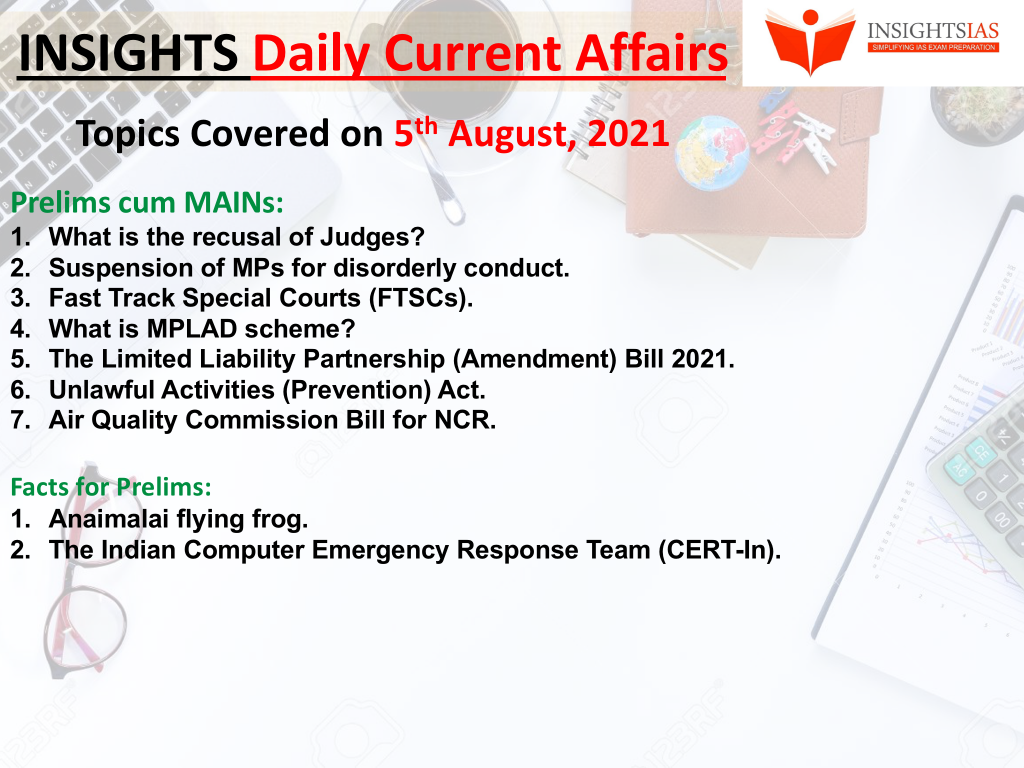[ad_1]
GS Paper 2:
Topics Covered: Appointment to various Constitutional posts, powers, functions and responsibilities of various Constitutional Bodies.
Context:
Six Trinamool Congress MPs were ordered to leave the Rajya Sabha for rest of the day by the Rajya Sabha Chairman over “grossly disorderly” conduct, after they entered the well of the house and displayed placards while protesting over the Pegasus scandal.
Rule 255 of the General Rules of Procedure of the Rajya Sabha:
The Chairman invoked rule 255 to suspend them.
- Under Rule 255 (‘Withdrawal of member’) of the General Rules of Procedure of the Rajya Sabha, “The Chairman may direct any member whose conduct is in his opinion grossly disorderly to withdraw immediately from the Council and any member so ordered to withdraw shall do so forthwith and shall absent himself during the remainder of the day’s meeting.”
How is suspension under Rule 255 different from Suspension under Rule 256?
Rule 256 provides for ‘Suspension of Member’; whereas Rule 255 provides for lesser punishment.
- Under Rule 256, “the Chairman may, if he deems it necessary, suspend a member from the service of the Council for a period not exceeding the remainder of the Session.
Differences in powers of Speaker and Chairman of Rajya Sabha:
- Like the Speaker in Lok Sabha, the Chairman of Rajya Sabha is empowered under Rule Number 255 of its Rule Book to “direct any Member whose conduct is in his opinion grossly disorderly to withdraw immediately” from the House.
- Unlike the Speaker, however, the Rajya Sabha Chairman does not have the power to suspend a Member.
Procedure to be followed for suspension of Rajya Sabha MPs:
- The Chairman may “name a Member who disregards the authority of the Chair or abuses the rules of the Council by persistently and wilfully obstructing” business.
- In such a situation, the House may adopt a motion suspending the Member from the service of the House for a period not exceeding the remainder of the session.
- The House may, however, by another motion, terminate the suspension.
Efforts to bring order in the House:
As Chairman of Rajya Sabha, Vice-President Ansari had attempted several steps to bring order to the House. In 2013, he mooted a number of radical solutions to maintain decorum. This included:
- Naming and shaming MPs in the Rajya Sabha bulletin for stepping outside House rules.
- Those named were to include members who came into the Well, or indulged in other grossly disorderly behaviour.
- The telecast of proceedings to be deferred to prevent visuals of disorder from being made public.
How can suspension of MPs be justified? Isn’t this an extreme step to take in order to curb unruly behaviour?
The solution to unruly behaviour has to be long-term and consistent with democratic values.
- There can be no question that the enforcement of the supreme authority of the Presiding Officer is essential for smooth conduct of proceedings.
- However, a balance has to be struck. It must be remembered that the job of the Presiding Officer is to run the House, not to lord over it.
Insta Curious:
Though rules with regard to Suspension of MPs are similar in Rajya Sabha and Lok Sabha, there are, however, a few changes. In Lok Sabha, under Rule 374A, there is a provision for “automatic suspension” of an errant member. When can this provision be invoked? Reference:
InstaLinks:
Prelims Link:
- Power to suspend MPs vs powers to revoke suspension.
- Difference in procedures followed by Lok Sabha and Rajya Sabha in this regard.
- Appeals with regard to election of MPs.
- Rules in this regard.
Mains Link:
The solution to unruly behaviour of MPs in Parliament has to be long-term and consistent with democratic values. Comment.
Sources: the Hindu.
[ad_2]

